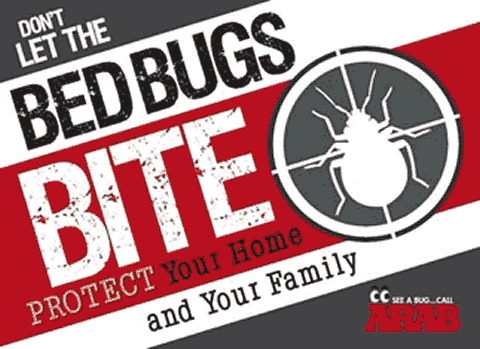Crickets
Information provded by Ohio State University.
| Common Name | Scientific Name |
|---|---|
| House Cricket | Acheta domesticus (Linnaeus) |
| Field Cricket | Gryllus spp. |
| Ground Cricket | Gryllus abbreviatus Serville |
| Nemobius fasciatus (DeGeer) | |
| Snowy Tree Cricket | Oecanthus niveus (DeGeer) |
| Camel Cricket | Ceuthophilus spp. |
| Northern Mole Cricket | Neocurtilla hexadactyla (Perty) |
Certain crickets occasionally invade homes and become a pest by their presence. Homeowners complain of their monotonous chirping, which can be annoying especially at night when trying to get some sleep. Indoors, some crickets can feed on a wide variety of fabrics, foods and paper products. Cotton, linen, wool, rayon, nylon, silk and furs are susceptible, along with soiled fabrics, sizing from wallpaper, glue from bookbindings, fruit, vegetables, meat and even other crickets. An occasional cricket or two in the home usually presents no serious problem. However, large populations may congregate around lights at night, making places unattractive.
Identification
Crickets get their name from the high-pitched sound or "chirp" produced when the male rubs his front wings together to attract a female. Different kinds of crickets can be identified by listening to their song.
The "True Crickets" (House, Field, Ground, Tree) resemble longhorned grasshoppers in having long tapering antennae, striculating (singing) organs on the front wings of the male and auditory (hearing) organs on the front tibiae (4th leg segment).
House Cricket
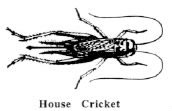 Adults are about 3/4 to 7/8 inch long, light yellowish-brown (straw-colored), with three dark bands on the head and have long, slender antennae much longer than the body. Wings lay flat on the back but are bent down abruptly on the sides. Females have a long, slender, tubelike structure (ovipositor) projecting from their abdomen (spearhead at the tip) for egg-laying. Both males and females have two antenna-like (cerci) attached to the sides at the end of the abdomen.
Adults are about 3/4 to 7/8 inch long, light yellowish-brown (straw-colored), with three dark bands on the head and have long, slender antennae much longer than the body. Wings lay flat on the back but are bent down abruptly on the sides. Females have a long, slender, tubelike structure (ovipositor) projecting from their abdomen (spearhead at the tip) for egg-laying. Both males and females have two antenna-like (cerci) attached to the sides at the end of the abdomen.
Field Cricket
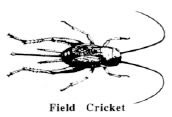 Adults range in size from 1/2 to 1-1/4 inches long depending on the species, are usually black-colored (sometimes brown), have long, slender antennae and a typical stout body (more robust than the house cricket) with large "jumping" hind legs. The ovipositor may be up to 3/4 inch long. Females have three easily seen appendages coming out of the tip of the abdomen, whereas males have only two. Most chirp and may sing both day and night.
Adults range in size from 1/2 to 1-1/4 inches long depending on the species, are usually black-colored (sometimes brown), have long, slender antennae and a typical stout body (more robust than the house cricket) with large "jumping" hind legs. The ovipositor may be up to 3/4 inch long. Females have three easily seen appendages coming out of the tip of the abdomen, whereas males have only two. Most chirp and may sing both day and night.
Ground Cricket
Adults resemble house and field crickets but are much smaller, usually less than 1/2 inch long, and brownish. Spines on the hind tibiae are long and movable. Their songs are often soft, high-pitched, pulsating trills or buzzes.
Snowy Tree Cricket
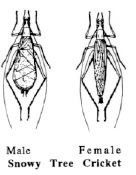 Adults are about 5/6 to 7/8 inch long, pale yellowish - green or whitish shaded pale green and have a single black spot on the front side of each of the first two antennal segments. Male wings are broad, paddle-like, and lay flat on the back at rest, whereas the female forewing is narrow, and wrapped closely about the body. They chirp at a regular rate varying with the temperature. A good approximation of the temperature in degrees Fahrenheit is to add 40 to the number of chirps in 15 seconds. These are the crickets commonly heard in the background noises of TV and movies. Most deliver loud trills.
Adults are about 5/6 to 7/8 inch long, pale yellowish - green or whitish shaded pale green and have a single black spot on the front side of each of the first two antennal segments. Male wings are broad, paddle-like, and lay flat on the back at rest, whereas the female forewing is narrow, and wrapped closely about the body. They chirp at a regular rate varying with the temperature. A good approximation of the temperature in degrees Fahrenheit is to add 40 to the number of chirps in 15 seconds. These are the crickets commonly heard in the background noises of TV and movies. Most deliver loud trills.
Camel Cricket
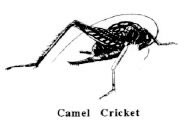 Adults, sometimes called cave or cellar crickets, are a little over 3/4 inch long, light tan to dark brown (darker bands on some segments), wingless, with head bent downward, back arched (humpbacked appearance), large hind legs and long antennae.
Adults, sometimes called cave or cellar crickets, are a little over 3/4 inch long, light tan to dark brown (darker bands on some segments), wingless, with head bent downward, back arched (humpbacked appearance), large hind legs and long antennae.
Northern Mole Cricket
Adults are 1/2 to 1-1/4 inches long, brownish to blackish-brown, with beadlike eyes. Their broad front legs are adapted for "digging" (they resemble front feet of a mole). They have rather short antennae, a large head and can fly.
Life Cycle and Habits
House Crickets normally live outdoors especially in garbage dumps, preferring warm weather, but will move indoors when it gets colder usually in late summer. Overwintering occurs outdoors in the egg stage. Each female can lay an average of 728 eggs with the immatures (nymphs) resembling the adults except being wingless. Nymphs molt seven to eight times and reach adulthood in about 60 days. Also, these crickets can live indoors, completing their life cycle with eggs laid in cracks, crevices and other dark areas such as behind baseboards.
Adults are very attracted to lights, and become active at night (hide during the day) to crawl, jump or fly sometimes in countless numbers up the sides of houses, entering openings of even second and third story windows and roof skylights. The continued, monotonous "chirp" is loud and distracting, resulting in lost sleep. They will feed on silk, woolens, nylon, rayon and wood. They can bite when handled carelessly. They are found in fields, pastures, lawns, roadsides and in woods.
Field Crickets overwinter as eggs or nymphs in moist, firm soil. Each female lays between 150 to 400 eggs which hatch in the spring. Nymphs resemble adults except are smaller and wingless, molt eight to nine times and reach adulthood in about 90 days. They are serious agricultural pests feeding on many crop plants. They become household pests in late summer and early fall when they move out of fields and into buildings. They can damage furniture, rugs and clothing and the "chirping" of adult males can be irritating. They are readily attracted to lights, can fly and are often found around dumpsters. Large swarms may invade well-lighted areas covering streets and the sides of buildings black with crickets. They feed on nylon, wood, plastic fabrics, thin rubber goods and leather. Outbreaks occur when rainfall follows a period of drought.
There are many different kinds and sizes of field crickets, none of which are able to survive and reproduce in buildings. They are found outdoors in similar places as are house crickets, especially under stones or boards, entering cool, moist basements in hot summers.
Ground Crickets act similar to field crickets except are smaller, overwinter as eggs, are largely active at night and attracted to lights. They occur in pastures, lawns and wooded areas.
Snowy Tree Crickets occur in trees, shrubs, weeds and high grass and are excellent singers, chirping at a regular rate varying with the temperature. Eggs are laid in the bark or stems of fruit and ornamental plants, often seriously damaging the twigs during the process of egg laying. Eggs are laid in pin-size holes (usually in single rows), sometimes injuring brambles of bush fruits. Overwintering eggs hatch in the spring with nymphs maturing in late summer. Apple, peach, plum, prune, cherry and berries are food hosts.
Camel Crickets are active at night in cool, damp, dark areas and occasionally invading damp basements or crawlspaces. They are not attracted to lights nor produce songs. Overwintering occurs as nymphs or adults in protected places. They may be found living in large numbers, causing alarm. Some textiles may be damaged. Some hide under hay bales, feeding on other insects seeking shelter there. Most are found in caves, hollow trees, under logs and stones and in other dark, moist places. They can live and reproduce indoors.
Northern Mole Crickets spend most of their life burrowing in the soil, coming to the surface as the soil is wet or flooded with rain. They are not often pests, but sometimes enter basements or homes. They fly to lights during their spring mating period. Females lay eggs in the soil (35 eggs per cell). Eggs hatch in 10 to 40 days with adulthood reached by autumn. They feed on roots, tubers and underground stems of grasses, strawberries, vegetables, etc. They overwinter as adults in the soil.
Chirping
There are special songs for courtship, fighting and sounding an alarm. The principle role is to bring the sexes together with different songs in different species. Male crickets stridulate or "sing" by rubbing a sharp edge (the scraper) at the base of one front wing along a filelike ridge (the file) on the bottom side of the other front wing, resulting in a series of "chirps." The number of chirps varies with the temperature with more (faster) chirping at higher temperatures. Chirps vary from four to five to more than 200 per second. The song is amplified by the wing surface.
Contact Us ~ We can help!
Hours of operation: Monday through Friday 7:30 A.M. to 4:00 P.M. EST
Arab Pest Control, a division of Lewellen Services, Inc.
232 West Main St., Logan, OH 43138
800-654-8870
![]()
![]()


![]()
Serving Central And Southeastern Ohio Since 1980 • Family Owned And Operated• Fully Licensed By The State And Bonded And Insured. • Termite Warranties • Licensed Technicians • Extensive Training and Retraining• Uniformed Technicians• Marked Vehicles• All Pest Services Offered• Able To Tailor Services To Fit Your Needs• Convenient Hours• Polite And Courteous Staff • We Use The Up To Date Chemicals And Treatment Methods To Protect Your Family And Pets • Many Treatment Services Offered• Senior Citizen Discounts



